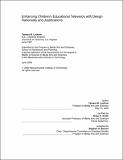| dc.contributor.advisor | Brian K. Smith. | en_US |
| dc.contributor.author | Lackner, Tamara M. (Tamara Magda), 1975- | en_US |
| dc.contributor.other | Massachusetts Institute of Technology. Dept. of Architecture. Program in Media Arts and Sciences. | en_US |
| dc.date.accessioned | 2005-05-19T14:27:55Z | |
| dc.date.available | 2005-05-19T14:27:55Z | |
| dc.date.copyright | 2000 | en_US |
| dc.date.issued | 2000 | en_US |
| dc.identifier.uri | http://hdl.handle.net/1721.1/16751 | |
| dc.description | Thesis (S.M.)--Massachusetts Institute of Technology, School of Architecture and Planning, Program in Media Arts and Sciences, 2000. | en_US |
| dc.description | Includes bibliographical references (leaves 57-60). | en_US |
| dc.description | This electronic version was submitted by the student author. The certified thesis is available in the Institute Archives and Special Collections. | en_US |
| dc.description.abstract | This research involves creating a system that provides parents with tools and information to help children learn from television. Children who converse with their parents during television viewing are better able to evaluate and make sense of content. However, children might learn more if they are encouraged to go from simply understanding content to generating questions and problem solving strategies. To do this, we need to deliver teaching and learning strategies to parents so they can initiate dialogues with their children around television. This research describes a system, called the Parent Trap, which sends messages to parents about the television shows that their children watch. The information in the messages tries to model dialogues that promote more frequent and longer conversations, which include inquiry and explanation. These conversations might facilitate additional learning from television and encourage further discourse between parents and children around other programs and activities. In the thesis, I suggest ways that television shows can be augmented with additional, digital information to help parents learn strategies for conversing with their children. I also present preliminary evaluations to show that developing these strategies may help television producers change the ways that they think about the educational value of their content. | en_US |
| dc.description.statementofresponsibility | Tamara M. Lackner. | en_US |
| dc.format.extent | 60 leaves | en_US |
| dc.format.extent | 598431 bytes | |
| dc.format.extent | 598126 bytes | |
| dc.format.mimetype | application/pdf | |
| dc.format.mimetype | application/pdf | |
| dc.language.iso | eng | en_US |
| dc.publisher | Massachusetts Institute of Technology | en_US |
| dc.rights | M.I.T. theses are protected by copyright. They may be viewed from this source for any purpose, but reproduction or distribution in any format is prohibited without written permission. See provided URL for inquiries about permission. | en_US |
| dc.rights.uri | http://dspace.mit.edu/handle/1721.1/7582 | |
| dc.subject | Architecture. Program in Media Arts and Sciences. | en_US |
| dc.title | Enhancing children's educational television with design rationales and justifications | en_US |
| dc.type | Thesis | en_US |
| dc.description.degree | S.M. | en_US |
| dc.contributor.department | Program in Media Arts and Sciences (Massachusetts Institute of Technology) | |
| dc.identifier.oclc | 47934081 | en_US |

